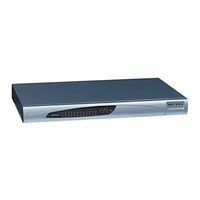User Manuals: AudioCodes Media Pack MP-114 VoIP Gateway
Manuals and User Guides for AudioCodes Media Pack MP-114 VoIP Gateway. We have 1 AudioCodes Media Pack MP-114 VoIP Gateway manual available for free PDF download: User Manual
AudioCodes Media Pack MP-114 User Manual (486 pages)
MediaPack series Voice over IP (VoIP) gateways
Brand: AudioCodes
|
Category: Gateway
|
Size: 6.06 MB
Table of Contents
-
1 Overview
19 -
-
-
Toolbar29
-
-
Accessing33
-
-
-
Getting Help52
-
-
-
-
-
-
-
SAS Parameters120
-
MP-11X & MP124
-
Routing Tables130
-
Hunt Group150
-
-
Management Tab157
-
-
Software Update168
-
-
-
-
-
-
-
-
NFS Parameters223
-
DNS Parameters224
-
DHCP Parameters226
-
-
Bootp Parameters238
-
-
HTTPS Parameters241
-
SRTP Parameters242
-
TLS Parameters244
-
SSH Parameters245
-
Ipsec Parameters246
-
OCSP Parameters247
-
SNMP Parameters250
-
-
-
MLPP Parameters306
-
Tone Parameters316
-
-
Voice Parameters346
-
DTMF Parameters353
-
-
-
-
Digit Mapping379
-
-
-
-
Fax Support402
-
Support403
-
-
-
Call Pickup425
-
Call Transfer426
-
Call Forward427
-
Call Waiting427
-
Caller ID429
-
-
-
-
-
Stun450
-
No-Op Packets452
-
-
IP Multicasting452
-
-
-
Routing Table465
-
-
-
13 Glossary
483
Advertisement
